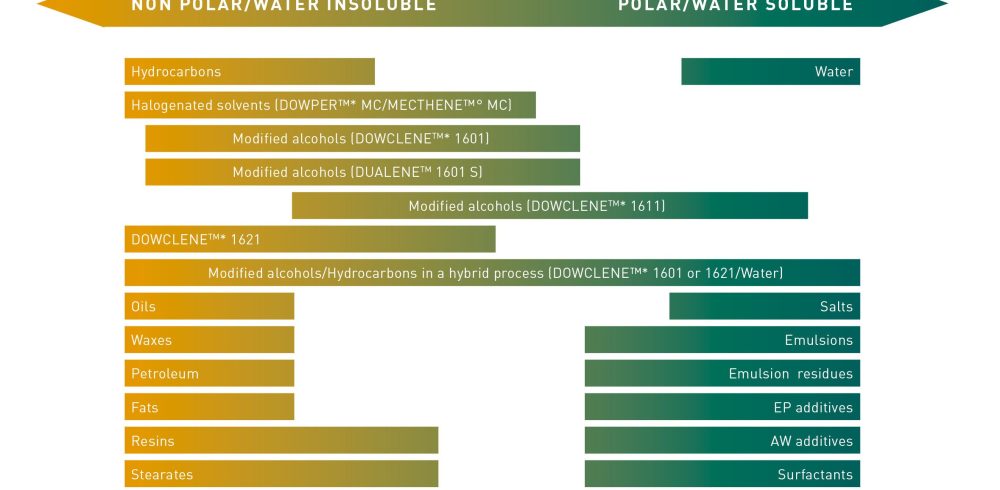Richard Starkey, Industry Manager – Aviation, SAFECHEM
Do the following issues sound familiar to you in your industrial parts cleaning process?
- residual contaminations
- surface stains on finished products
- high cleaning costs
If your parts cleaning process is not delivering effective and consistent results, you might want to take a closer look at your cleaning approach. One cleaning medium might work better than the others depending on your specific application and requirements.
But how should you go about selecting the right cleaning medium? Achieving the cleaning quality required is just one part of the equation. It is equally important to ensure that your parts cleaning process is economically viable, safe and sustainable. We have outlined below 4 key questions you should consider in your evaluation.
1. What are your cleaning quality requirements?
Knowing the required cleaning quality requirements is fundamental to choosing the right cleaning agent. In order to achieve optimal cleaning results, you need to consider two different kinds of soils:
1) particle contaminations, including their size, numbers and types and
2) the sort of filmy contaminations.
Aqueous cleaning agents have a density of approx. 1g/ml. Solvents, in comparison, may have a higher or lower density. “Heavier” cleaning agents are effective in removing particulates that cannot be readily dissolved. They can literally “push” or ”float away” particulates and lift them off the surface.
At the same time, different industrial applications necessitate varying degrees of surface energy of the metal surface, which is influenced by filmy contaminations. With nitriding or crack detection, for example, a higher surface energy is required than with standard coating or assembling. The required surface energy should therefore match the ability of the cleaning agent.
For precision cleaning where required surface energy can range anywhere from 38 mN/m to approx. 60 mN/m, both aqueous-based cleaning and solvents are capable of fulfilling the requirement.

In aqueous cleaning, as soils and contaminations are emulsified and flooded off the surface which remain in the water (unless specific procedures are performed to purify the water), the quality of cleaning will mainly depend on the quality of the rinsing baths, as well as the number of the rinsing baths with demineralized water. The higher the required quality of cleaning, the investment and space requirements for the aqueous systems will increase accordingly.
2. What is the affinity of the cleaning agent to the soils?
Effective cleaning is based on the principle “Equal dissolves equal”. For water-based (polar) types of contaminations such as coolant and lubricant emulsions as well as solids like chips, salt, residues of polishing pastes and particles, aqueous cleaning agents are typically the first choice. These are available in neutral pH, alkaline and acidic formulations, and a huge variety of surfactants and other ingredients.
When removing mineral oil based, non-polar contaminations, such as machining oils, greases and waxes, solvent will commonly be the preferred cleaning agent.
Nowadays modified alcohols are also available; due to their both non-polar and polar properties, they are able to clean non-polar contaminations as well as certain polar contaminations. This type of solvents has a much broader application range compared to traditional non-polar solvents.
3. What metal types are you cleaning and how are they configured?
In water-based processes, cleaning agents which can be acidic, neutral or alkaline, are usually matched to specific metal types. Simultaneous cleaning of different metals can therefore be problematic and this can result in compatibility issues and in worst case: corrosion.
Solvents in comparison have universal compatibility with metals. If the component parts are tiny or have complex geometry or small crevices, solvent is often recommended due to its lower surface tension and viscosity which makes it easy to wet into and evaporate out of tight spaces.
With water-based cleaning, even tiny traces of residue moisture could give rise to issues such as challenges in subsequent production processes, corrosion, or growth of bacteria and related bioburden issues.
4. What is the environmental impact?
The energy consumption in a water-based process can be significant, due to the energy requirement to operate high-pressure pumps; heat the cleaning water; dry the metal parts; as well as treat and purify used water for re-use or disposal. Depending on the cleaning agents, dirts and soils are emulsified and the contaminations diluted in the water. As a result, aqueous baths that are not treated have to be replaced frequently.

Solvent in closed vacuum vapor degreaser can be recycled again and again via the built-in distillation unit. This can significantly increase solvent lifespan and cut down on waste volume. While energy is required to keep the closed cleaning machine under vacuum, this also lowers the boiling points of solvents, hence accelerating their evaporation and enabling quick drying of metal parts within a shorter cycle time.
There is no one-size-fits-all solution
The questions listed above only provide a few key pointers, and there are many more factors to consider. In particular, every industrial process is unique within its own specific context, so are the goals and the requirements. No one cleaning method would work universally; it takes a comprehensive evaluation to identify the most suitable cleaning method for your specific application. Ultimately, the optimal cleaning solution should work to balance technical, economical and environmental needs.
For a complete overview and in-depth explanations on the 10 questions key to industrial parts cleaning success, download our free guidance paper.
Manufacturing & Engineering Magazine | The Home of Manufacturing Industry News









